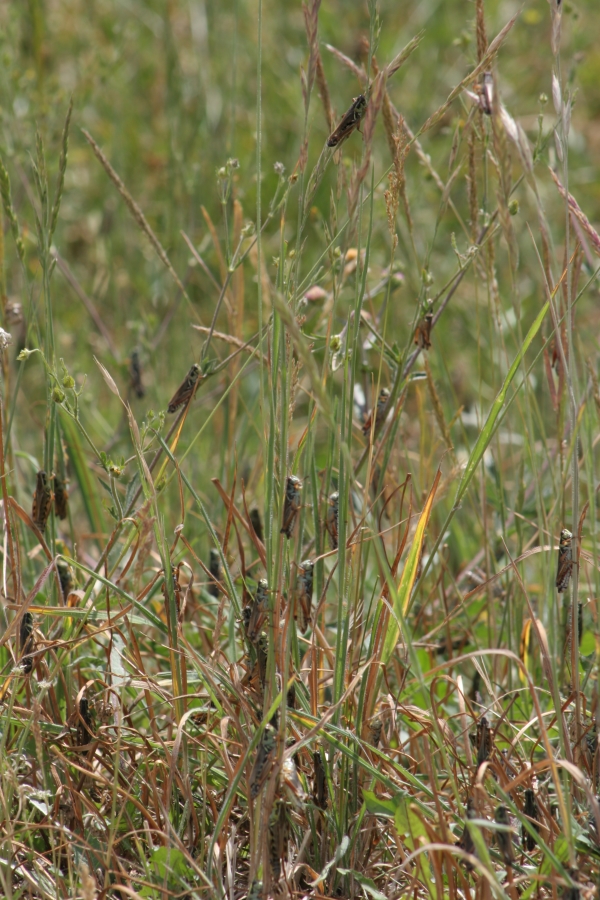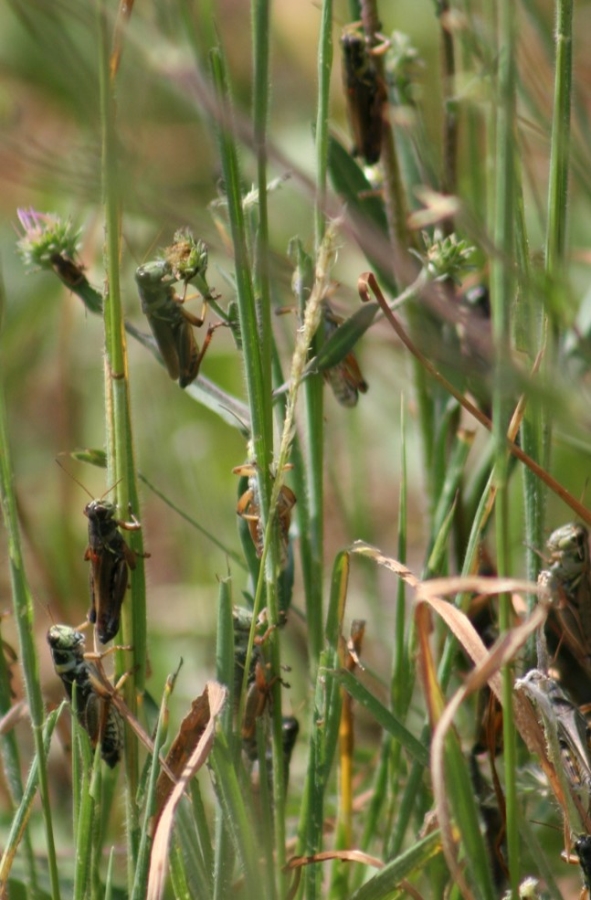Hemp farmers, processors, and other stakeholders in some of the largest hemp-growing states in the country are facing the prospect of challenges seen in 2020 intensifying this season: Along with this year’s historic drought and heat is the renewed threat of grasshoppers and other voracious insects preparing to eat everything in their path.
A 2021 “Rangeland Grasshopper Hazard Map,” issued by the U.S. Department of Agriculture’s Animal and Plant Health Inspection Service (USDA APHIS), shows infestations across 13 states. Severe outbreaks have been documented in Montana, Wyoming, and Oregon, as well as across parts of Idaho, Colorado, Nebraska, and Arizona.
Ideal Conditions for an Outbreak
This season’s severe drought has created an ideal environment for the proliferation of grasshoppers, Mormon crickets, and other insects that usually fall prey to fungi during wetter seasons, but thrive in the current dry conditions. “We see a six to eight-year cycle with grasshoppers, we see a 20-year cycle with Mormon crickets,” Kristopher Watson, state entomologist at the Utah Department of Agriculture and Food, said in a recent interview with Fox 31 in Salt Lake City. “And what we’re kind of seeing is them starting to come together.”
Grasshopper and Mormon cricket infestations have been reported across Utah. Watson said they are now starting to see “10,000 or 20,000-infested acres of grasshoppers,” with upwards of 100 grasshoppers per square yard.
Learning from Last Year
Montana – which has consistently been among the largest hemp-producing states, although mostly for grain – was particularly hard-hit by grasshoppers last year. “In 2020, in central Montana, we certainly had some hemp losses in some grain production [areas] that approached 100% because of grasshoppers,” said Ian Foley, Agricultural Sciences Division Administrator at the Montana Department of Agriculture. Foley told Hemp Benchmarks that part of the problem last year in his state was hemp’s relative newness as a mainstream crop. “With hemp being a new crop, not being available for research for decades … there isn’t a full suite of plant protection products available that are registered by EPA [Environmental Protection Agency],” he said.
Foley noted that his state’s hemp industry is trying to learn from last year’s grasshopper devastation. “Looking at 2021, some of those same growers, some of those same companies are proactively scouting their populations of grasshoppers, and are looking at products that they can use that will effectively protect those crops for 2021, if the grasshopper situation gets as bad as they were in 2020,” he said.
The Pesticide Dilemma
Suppressing grasshoppers is never an easy task and not many mainstream pesticides are useful. “Insecticides are not very effective on grasshoppers because few can penetrate their thick exoskeletons,” Punya Nachappa, Associate Professor at Colorado State University’s (CSU) Department of Agricultural Biology, said in an email to Hemp Benchmarks.
According to Ian Foley, Montana’s hemp cultivators have to follow the state’s “regulatory thinking” regarding pesticide use on hemp; specifically, products have to be approved for both the farming site and the crop, and hemp has to be mentioned on the pesticide label. “As of today there are 59 pesticides registered by EPA for use on hemp,” he said. “Most of those are biopesticides. There are also ‘minimum-risk products’ registered at the state level only.”
Biopesticides are naturally occurring substances that control pests via non-toxic means. One example of a grasshopper-specific biopesticide, Foley said, is the pathogen Beauveria bassiana. There are also pathogenic fungi and EPA-approved treatments for hemp such as neem oil, a naturally-occuring pesticide made from neem tree seeds. However, biopesticides tend to be less effective and more costly than traditional pesticides. “A lot of these are designed for greenhouse use or small farm use,” Foley noted, “so a lot of them would be cost-prohibitive.”
Grain hemp growers, he added, must take special care because they are producing an edible product. “The real issue is with hemp as a food crop,” Foley pointed out, “none of the active ingredients in traditional pesticides have tolerances established for hemp as a human food. So that essentially eliminates most of those traditional active ingredients because there are no food tolerances established.” As a result, Montana growers are looking at last year’s experience and working to protect their crops without the use of pesticides on the plants themselves.
Other Tactics
There are other tactics hemp growers can use to combat grasshoppers, such as actively scouting their fields for grasshopper nymphs, doing perimeter treatments, and otherwise protecting the borders of their fields. While many hemp farmers might find they have a limited arsenal of tools against grasshoppers and other pests, Foley said the cultivators in his state are also implementing changes to their farming practices to help protect crops against the voracious insects.
For example, “You got growers now looking at their seeding rate per acre,” he said, “because in areas where their seeding rate was lower, the hemp plants actually developed larger stalks, which then prevented the grasshoppers from chewing through the stalks and lodging the plants over and actually protected the [hemp] grain crop. The grasshoppers stripped off all the leaves, but they left that grain head on [plants in areas with] the lower seeding rates. So some of those kinds of integrative practices, growers are already learning those just from a few years of high grasshopper pressure.”
According to Punya Nachappa at CSU, “hemp can tolerate some leaf loss and low levels of grasshopper defoliation with no effect on yield. Younger hemp crops are more susceptible to damage. But two species of large grasshoppers can be damaging even to mature hemp: the differential grasshopper and the two-striped grasshopper.”
Image Source: USDA-APHIS
USDA Suppression Efforts and Organic Hemp Farming
In late June, according to the Associated Press, the USDA began a campaign of aerial pesticide spraying to destroy grasshopper nymphs before they develop into ravenous adults. Bill Wesela, National Policy Manager at APHIS, warned that uncontrolled infestations could cause “significant economic losses” for U.S. livestock producers by reducing the forage available on rangelands.
“That forces producers to buy supplemental feed or sell their livestock at reduced prices,” Wesela said in an email to Hemp Benchmarks. “Besides feeding on grasslands, large grasshopper and Mormon cricket populations can also devastate cultivated crops such as alfalfa, barley, corn, and wheat.” Furthermore, Wesela noted grasshopper outbreaks affect bee colonies and wild plant pollinators by destroying or reducing flowering plants.
However, the USDA pesticide program is alarming environmentalists, who say the widespread spraying campaign will kill other beneficial insect species. It could also, they say, potentially ruin organic farms near the spray zones if pesticides drift onto organically-grown crops.
Most of the hemp grown in Montana is for grain and about one-third of the state’s hemp crop is grown organically, according to Ian Foley. “We had just under 3,500 acres of certified organic hemp in 2020,” he said, “and are expecting around 2,000 organic acres this year.”
Pesticide drift, he added, is always a concern. “There’s lots of requirements on the product labels to mitigate drift,” he said. “We have an entire enforcement group in our department to handle drift issues when they do occur. There’s a process for handling drift complaints; there’s also an application process on all product labels that have the potential for drift, to manage that drift.”
Developing New Tools
CSU’s Nachappa said insect outbreaks are likely to become more common due to climate change. “Given the limited organic control options for grasshoppers,” she noted, “I hope we can test alternatives to pesticides for such outbreaks in the future.”
Bill Wesela at APHIS said his agency “continuously investigates and funds research into new methods and products to increase the Grasshopper and Mormon Cricket Program efficiency and effectiveness and decrease environmental effects. Ongoing research at APHIS includes biopesticide development, molecular insecticides, and novel management tools.”
For his part, Ian Foley said grasshoppers are a cyclical problem across the Western rangeland and cropping system. “As hemp becomes a common rotational crop in those systems, farmers will develop the tools to protect those crops from grasshoppers in the future,” he said. “And they’ve already learned a lot from 2020.”




